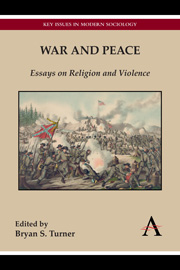Book contents
- Frontmatter
- Contents
- Acknowledgments
- Contributors
- Introduction by Bryan S. Turner
- War
- Peace
- Chapter 5 Quakers, the Origins of the Peace Testimony and Resistance to War Taxes
- Chapter 6 A Sacred Ground for Peace: Violence, Tourism and Sanctification in Hiroshima 1960—1970
- Chapter 7 The Sectarian as a Category of Secular Power: Sectarian Tensions and Judicial Authority in Lebanon
- Chapter 8 The Commodification of Love: Gandhi, King and 1960s Counterculture
- Chapter 9 The Religion of Brotherly Love: Leo Tolstoy and Max Weber
Chapter 8 - The Commodification of Love: Gandhi, King and 1960s Counterculture
from Peace
Published online by Cambridge University Press: 05 May 2013
- Frontmatter
- Contents
- Acknowledgments
- Contributors
- Introduction by Bryan S. Turner
- War
- Peace
- Chapter 5 Quakers, the Origins of the Peace Testimony and Resistance to War Taxes
- Chapter 6 A Sacred Ground for Peace: Violence, Tourism and Sanctification in Hiroshima 1960—1970
- Chapter 7 The Sectarian as a Category of Secular Power: Sectarian Tensions and Judicial Authority in Lebanon
- Chapter 8 The Commodification of Love: Gandhi, King and 1960s Counterculture
- Chapter 9 The Religion of Brotherly Love: Leo Tolstoy and Max Weber
Summary
Introduction
This essay explores why global revolutions ceased to utilize the politically transformative power of love after the activism of Gandhi and Martin Luther King by drawing connections between their religiously couched “ethic of love” and the secular capitalist commodification of 1960s hippie counterculture. Gandhi and King, utilizing their respective religious frameworks, practiced revolutionary techniques to make their opponents act in the interest of “selfless love,” or agape in the Christian sense. By the association of hippie counterculture, however tangential, to this socially transformative power of love, corporate advertising during the 1960s effectively confused love of the agape and eros (erotic) varieties, hollowing out the term by the 1970s, and robbing love of its revolutionary potential. Our paper will be broken down into three parts: The first will discuss how Gandhi and King used the ethic of selfless love to revolutionary ends. The second will examine how the hippie counterculture of the 1960s was influenced and shaped by this ethic of love, and how, what Thomas Frank calls, “the rise of hip consumerism” (Frank 1997, iii) not only commodified hippie counterculture, but also commodified love as a political tool. Lastly, we will look at some political deployments of the ethic of love from the 1970s to the present, including the Chipko movement, or “treehuggers,” an Indian environmentalist group that used Gandhian techniques to bring awareness to deforestation.
- Type
- Chapter
- Information
- War and PeaceEssays on Religion and Violence, pp. 163 - 184Publisher: Anthem PressPrint publication year: 2013

